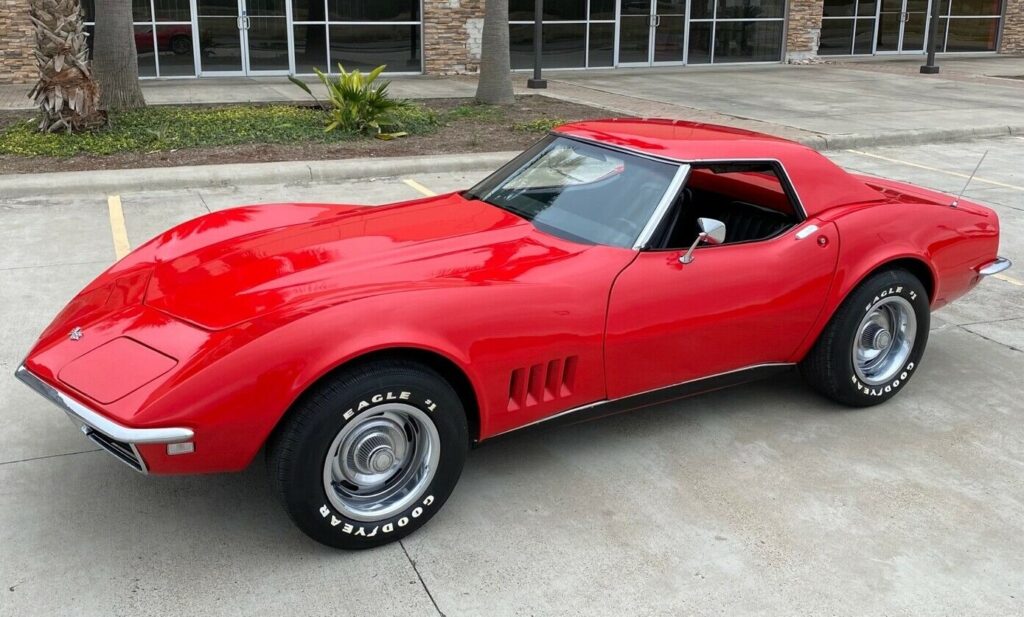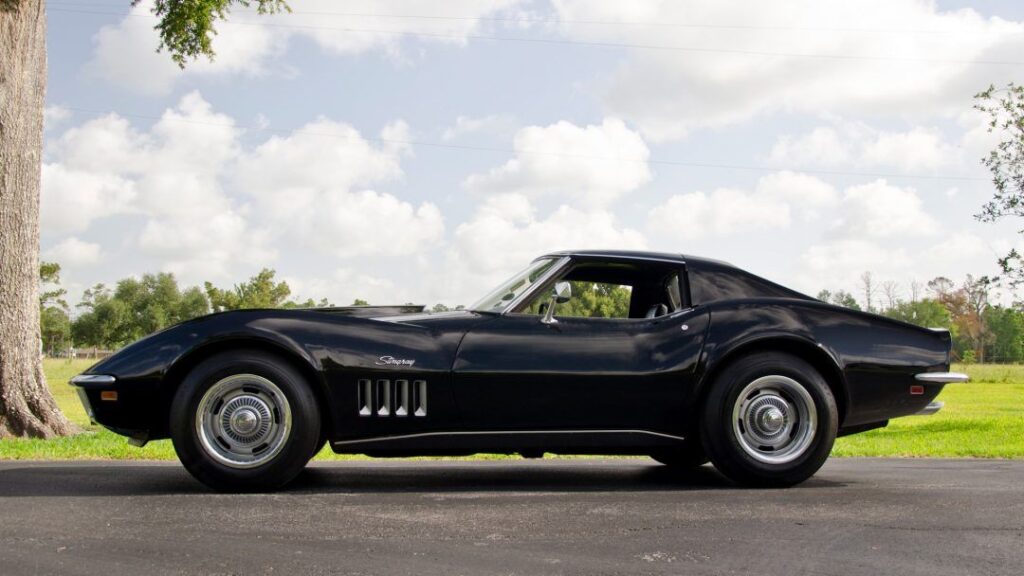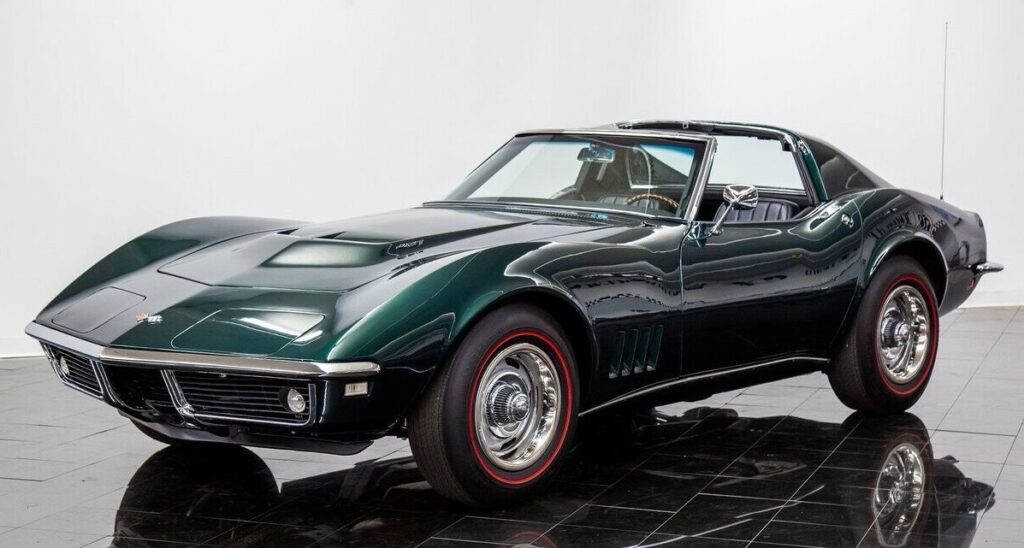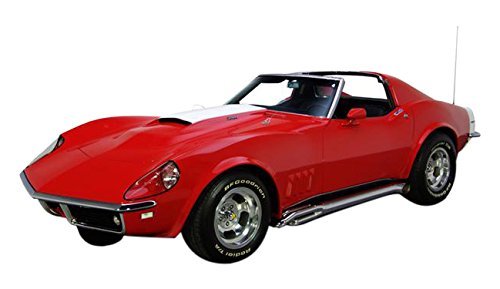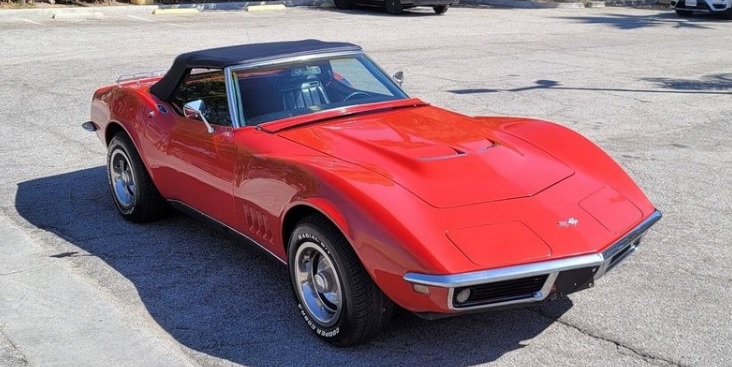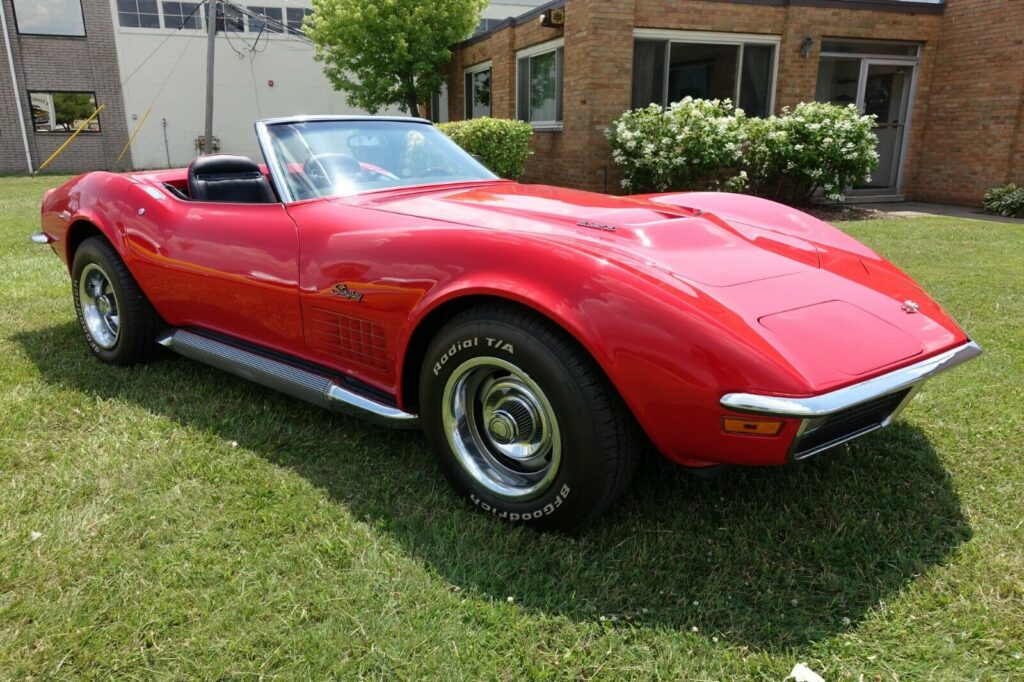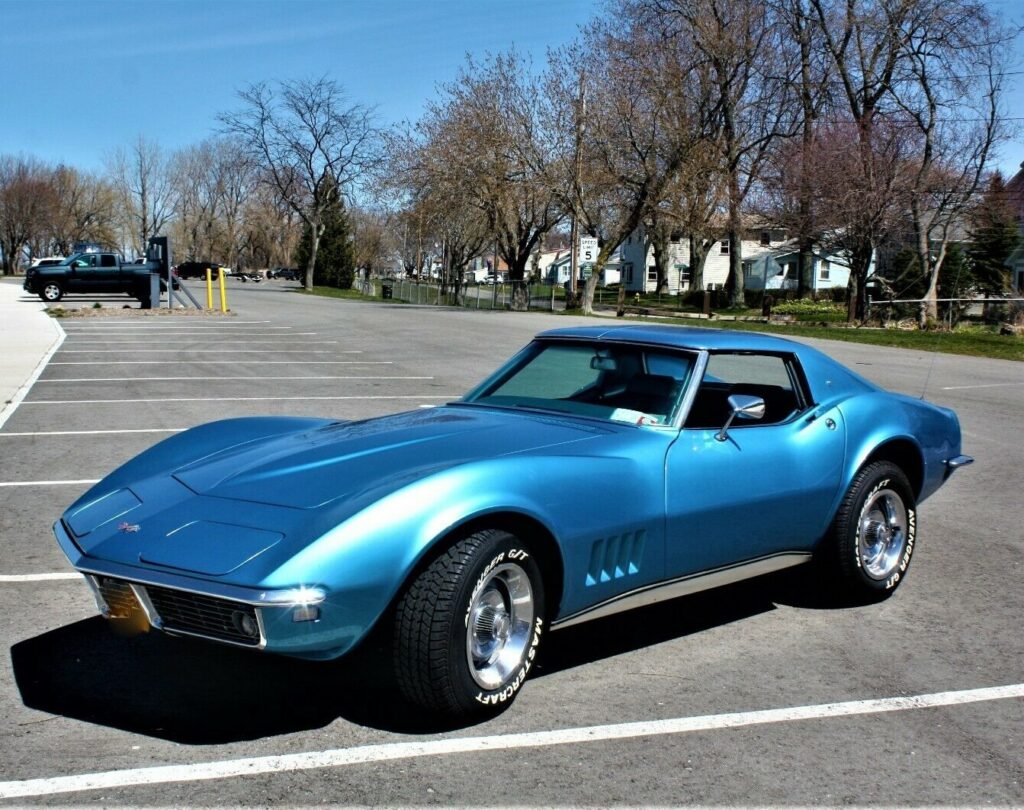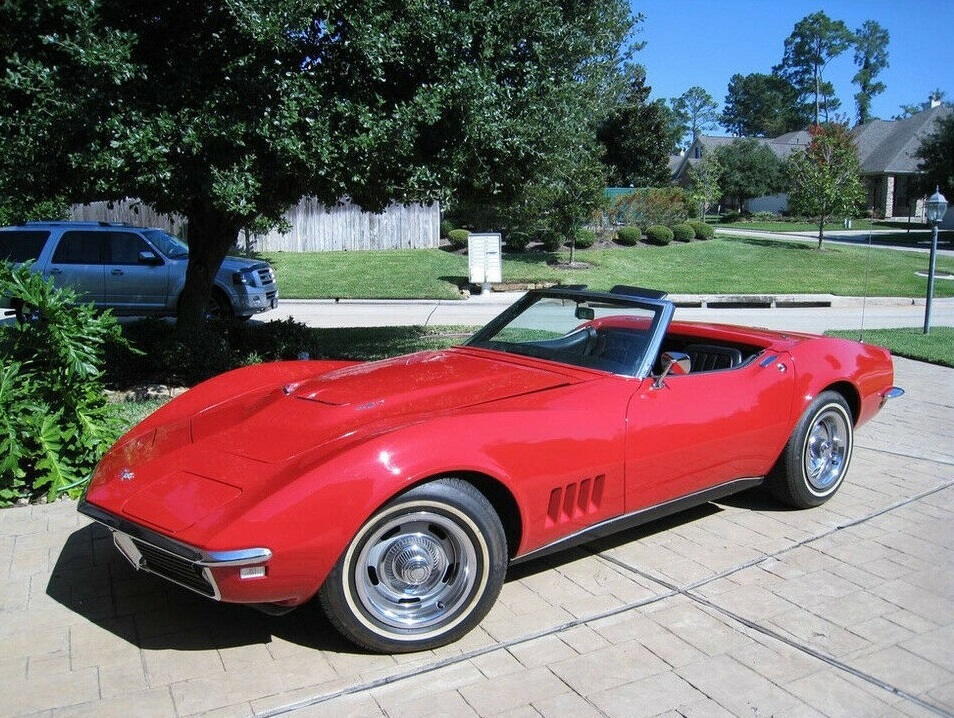“Corvette ’68… all different all over”. 1968 was a year of bold new design changes for the Corvette. The ’68 vette underwent a complete body redesign, shifting towards that almost convertible feel with removable T-tops and a removable back window.
Go hardtop
Uncap it
Settle Down
Take Control
The mechanical part of Frame, chassis and power team members give the enthusiast precise handling of a smooth-but-hustling road car.
Body- A network of steel integrated with body panels for increased rigidity and strength. The fiber glass body parts are bonded directly to the steel frame rather than to riveted bonding strips as in the past. Both the Sting Ray Coupe and Convertible bodies are given extra strength through increased supports and support reinforcements.
Frame- All-welded, full-length, ladder-constructed with five crossmembers. Side rails and intermediate crossmembers box section; front crossmember box girder section. Eight body mounting points plus two radiator mounts.
Suspension- In front, independent type with coil springs and concentric shock absorbers. Spherically jointed steering knuckles for each wheel. Reinforced stamped steel control arms with pre-loaded steel-encased rubber bushings at pivots. Double-acting hydraulic shock absorbers with 1″ piston diameter. Link-type stabilizer bar of steel with rubber bushings. Anti-dive control is achieved through the angle of front upper control arm. Rear suspension is fully independent with frame-anchored differential. Locus of each wheel is established by three links: universal jointed axle shaft, adjacent strut, and a torque control arm pivoted at frame side rail. Vertical suspension loads taken by shock absorbers and transversely positioned nine-leaf spring.
Rear Axle- Semi-floating straddle mounted hypoid gear with 3.7 pint capacity. MPH is final drive with various rear axle ratios per 1000 rpm; 2.73-28.6; 3.08-25.4; 3.36-23.3; 3.55-22.0; 3.70-21.1; and 4.11-19.0 (these are calculated for new F70-15 wide oval tires without allowance for tire slippage or expansion).
Steering- Semi-reversible, recirculating ball-nut steering gear with GM-developed energy absorbing column. Steering damper between frame and relay rod mounted on the tie rod. Dual-mounted steering arm tie rod connection permits a choice between street or fast ratio. Turning diameter curb to curb- 39.9 ft. Number of turns lock to lock with street steering- 3.4 fast- 2.92, Power steering is a pump-powered hydraulic cylinder assisting the parallelogram linkage. Number of turns lock to lock with power-steering- 2.92.
Brakes- First American production car to use disc brakes at all four wheels. Dual circuit master cylinder with warning light. Braking effort is distributed 65% to front and 35% to rear. Construction is cast iron caliper type with radial cavities for heat dissipation. Sweep area is 461.2 square inches. Linings are woven asbestos; gross lining area is 81.7 square inches. Parking brake is mechanically operated on rear wheels separate from service brake system. Drum diameter of parking brake is 6.5″. Linings consist of two shoes per rear wheel with gross lining area of 33.9 square inches. Power brakes with new tandem diaphragm vacuum unit could be specified to lessen the required amount of pedal pressure.
Engines- All corvette engines used cast iron alloy cylinder blocks. Full-lengthwater jackets surround each cylinder for optimum cooling. Cylinder heads are high chrome cast iron alloy. Total combustion chamber volumes, piston top center, are: 300-hp-4.69-cu-in; 350-hp-4.17-cu-in; 390- and 400-hp- 5.90- cu- in; and 435-hp-4.92-cu.-in. Inlet manifold on 300- and 350-hp engines is of cast iron alloy. With 390- 400- and 435-hp, inlet manifold is of cast aluminum alloy. Exhaust manifolds on all engines are cast iron alloy. The 327 engines utilize dual 4-port exhaust flow to a single outlet runner at the center; 427s use dual 4-port extended runners from each port converging to a rear outlet. Rugged alloy steel crankshaft with five main bearings in all engines. Crank arm length: 327-1.625;427-1.8. There are 6 counterweights on all cranks. Rubber mounted inertia torsional damper. Steel sprocket and chain timing gear. Camshaft in all engines is cast iron alloy with 5 steel-backed Babbitt bearings. Valve train in each engine includes stamped individually mounted overhead rocker arms. Push rods actuated with hydraulic lifters (except the 435-hp which has solid lifters). Intake valves are steel alloy. Overall head diameter of intake valves in 300-hp engine is 1.935-1.945; 350-hp-2.017-2.023; 390 and 400-hp mills- 2.060-2.070 and 2.185-2.195 in the 435-hp. Exhaust valves are of steel alloy. Head diameters: 300-hp-1.495 -1.505; 350-hp – 1.595-1.605 and 1.715-1.725 in all the 427 engines. Rochester 4-barrel downdraft carburetors are used in the 300-,350- and 390-hp engines while the 400- and 435-hp power plants utilize a Holley triple 2-barrel downdraft system. All Corvette engines in ’68 feature Air Injection Reactor equipment to control exhaust emission.
Transmissions- The standard 3-Speed transmission available only with the 300-hp engine has these gear ratios: first- 2.54:1; second- 1.50:1; third 1.00:1 and reverse- 2.63:1. 4-Speed ratios are: first- 2.52:1; second- 1.88:1; third- 1.47:1; fourth- 1.00:1; reverse-2.59:1. The special 4-Speed close-ratio transmission goes: first- 2.20:1; second- 1.64:1; third- 1.27:1; fourth-1.00: 1; and reverse- 2.26:1. All forward gears in manual transmissions are fully synchronized. A single dry disc centrifugal clutch is used with all manual transmissions. Turbo Hydra-Matic gear ratios: first- 2.48:1; second-1.48:1; third-1.00:1; and reverse-2.08:1.
Dimensions- Wheelbase-98.0″. Width overall-69.2″. Length overall- 182.1″. Tread-front: 58.3″; rear: 59.0″. Height (loaded) overall- Coupe: 47.8″; Convertible: 47.9″. Curb weight- Coupe: 3210; Convertible, 3220.
Fuel Tank: For the first time in Corvette, a 20-gallon plastic fuel tank. Weighs less than conventional tank and eliminates chances of rust and corrosion.
Engine Specifications
| Feature | Base RPO L75 | RPO L79 | RPO L36 | RPO L71 | RPO L88 |
|---|---|---|---|---|---|
| Type | V-8, Overhead valve | ||||
| Block | Cast iron block | ||||
| Displacement | 327 cid | 427 cid | |||
| Bore & Stroke | 4.00 x 3.25″ | 4.251 x 3.76″ | |||
| Compression ratio | 10.25:1 | 11.0:1 | 10.25:1 | 11.0:1 | 12.5:1 |
| Brake horsepower | 300 @ 5000 | 350 @ 5800 | 390 @ 5400 | 435 @ 5800 | 560 @ 6400 |
| Torque | 360 lb-ft @ 3400 | 360 lb-ft @ 3600 | 460 lb-ft @ 3600 | 460 lb-ft @ 4000 | |
| Main bearing | Five | ||||
| Valve lifters | Hydraulic | Mechanical valve lifters | |||
| Camshaft | High-performance camshaft | Special-performance camshaft | Special ultra-high-performance camshaft with .5365-inch intakes | ||
| Fuel supply | Rochester Type 4MV four-barrel Model 7028207 | Holley four-barrel | Three Holley two-barrels | Single Holley 850CFM four-barrel |
Colors:
- Tuxedo Black
- Polar White
- Rally Red
- Lemans Blue
- International Blue
- British Green
- Safari Yellow
- Silverstone Silver
- Cordovan Maroon
- Corvette Bronze
Interior colorS:
- Black
- Red
- Blue
- Medium Blue
- Orange
- Tobacco
- Gunmetal
Production Options and Build Statistics
- Total 1968 Corvettes Built – 28,566
- Convertibles – 18,630
- Coupes – 9,936
Mechanical Dimensions
| Feature | Convertible | Coupe |
|---|---|---|
| Wheelbase | 98 inches (2.489 m) | 98 inches (2.489 m) |
| Overall length | 182.1 inches (4.625 m) | 182.1 inches (4.625 m) |
| Overall width | 69.2 inches (1.758 m) | 69.2 inches (1.758 m) |
| Overall height | 48.6 inches (1.234 m) | |
| Front tread | 58.3 inches (1.481 m) | 58.3 inches (1.481 m) |
| Rear tread | 59.0 inches (1.499 m) | 59.0 inches (1.499 m) |
| Frame | Full-length ladder type with five cross members. Steel box sections, welded. | |
| Front suspension | Independent, unequal-length A-arms, coil springs; tubular shocks and stabilizer bar | |
| Rear suspension | Independent, trailing arms, toe links, transverse chromium-carbon steel leaf spring, tube shocks, and anti-roll bar | |
| Steering | Saginaw recirculating ball, 17.6:1 ratio, 2.9 turns to lock, 39.9 turning circle | |
| Rear axle type | Sprung differential, Hypoid gear | |
| Brakes | Hydraulic, vented four wheel discs; 11.8-inch diameter, single calipers | |
| Total swept area | 259 sq. in. per ton, 461.2 sq. in. total | |
| Wheels | 6″ wide slotted steel 15″ 5-lug disc | |
| Standard rear axle ratio | 3.36:1 | |
| Optional rear axle ratio | 3.08:1, 3.36:1, 3.55:1, 3.70:1, 4.11:1, 4.56:1 |
Fast Fact:1968 was also the year that Zora Arkus-Duntov was named Chief Engineer of the Corvette.
Sunny afternoon view of this classic red C3 1970 Chevrolet Corvette convertible.
Wonderful view of this classic red C3 1976 Chevrolet Corvette coupe
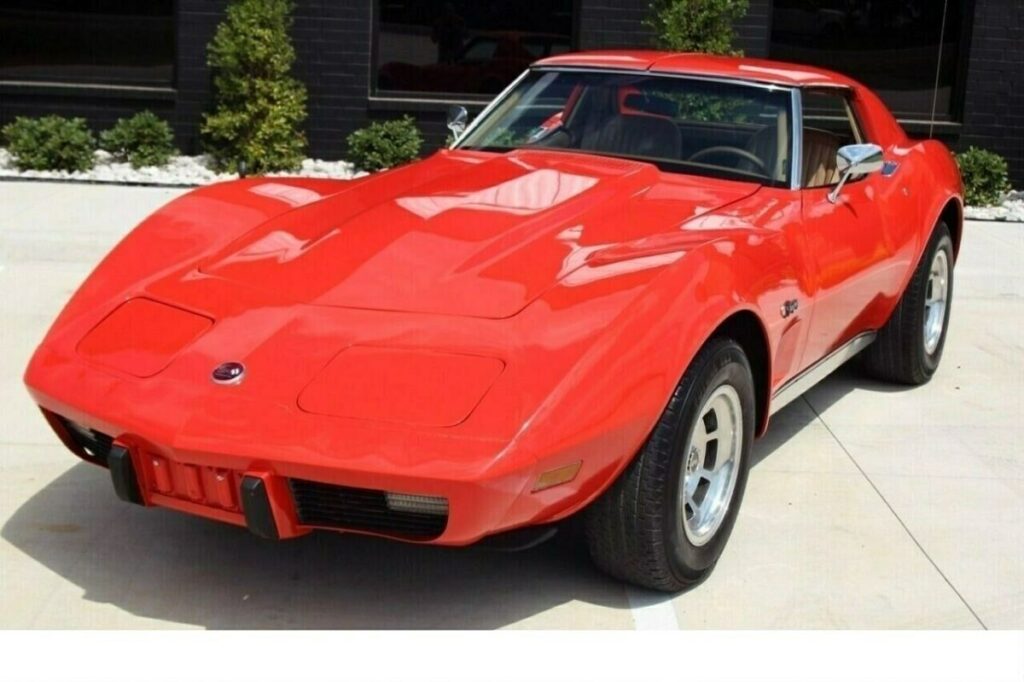
Sunny afternoon view of this classic blue C3 1968 Chevrolet Corvette Coupe
Sunny outdoor view of this classic red C3 1968 Chevrolet Corvette L-36 convertible
Wonderful afternoon outdoor view of this classic red C3 1968 Chevrolet Corvette coupe.
